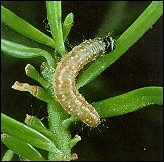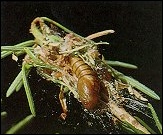

Spruce Bud Worm

Outbreaks of spruce budworm usually occur in mature forests on white, black, and Engelmann spruces and balsam fir. Infestations may also spread to rural and urban areas, where shelterbelts and ornamentals of Colorado spruce are also attacked.
The first noticeable sign of damage occurs in early June when needles in the new foliage at the top of the tree turn reddish brown. This is caused by larvae that feed first on the buds and developing shoots, then on the needles. They web partially eaten needles together to form a shelter.
In severe infestations all the new foliage, together with some of the older needles, may be eaten for several consecutive years, causing trees to lose their vigor. In 3 years the tree top dies, and in 5 years the tree dies. To keep trees healthy every effort must be made to control this insect at the first sign of damage.
Birds, predatory insects, spiders, parasites, and disease play a major role in regulating budworm populations. Weather is also extremely important, because colder than normal spring temperatures and late frosts kill many young larvae. On the other hand, warm dry spring conditions are ideal for larval survival. Natural controls are not very effective when populations increase to epidemic proportions, and applied control becomes necessary to save your trees.
If only a few small trees are involved, picking the larvae off by hand early in the season and destroying them can be effective. On large trees or a large number of trees, spraying with insecticides may be required to obtain satisfactory control. A biological insecticide, Bacillus thuringiensis var. Kurstaki (Dipel WP or Organic Garden Spray), which is produced from naturally occurring organisms, provides adequate control and is nontoxic to bees, parasites attacking the budworm, animals, birds, and fish. Dipel WP is applied at the rate of 2 tsp/gal of water (7 g/5 L). Organic Garden Spray is applied at the rate of 2 tsp/gal of water (10 ml/5 L) and is also available as an aerosol.
Approved and registered chemical insecticides are trichlorfon (Dylox 50 EC) which is relatively non-toxic to beneficial parasites, predators, and pollinators; malathion; and dimethoate (Cygon 4E) 50% emulsifiable concentrates. Any one of these emulsifiable concentrates can be applied at the rate of 2 tsp/gal of water (10 ml/5 L).
In all cases spray with a hand, compressed-air, or garden-hose sprayer when larvae first appear (about mid-May), before damage becomes noticeable from a distance; otherwise, a large amount of the current year's damage will have already occurred. Drench the foliage thoroughly and repeat the application at 7-day intervals as required to maintain control. Malathion should not be applied when the temperature is lower than 20 C.
CHEMICAL INSECTICIDES ARE TOXIC TO HUMANS, ANIMALS, BIRDS, AND FISH. FOLLOW ALL DIRECTIONS AND PRECAUTIONS LISTED BY THE MANUFACTURER.The adult of the spruce budworm (scientific name Choristoneura fumiferana Clem.) is a small brown moth about 1/2 in. (1.3 cm) long that generally appears in late June to early July. Females mate soon after emerging, lay some of their eggs, and are then capable of flight. Each female moth lays over 100 green eggs in clusters of 15-20 on the underside of needles. Eggs hatch in about 10 days, and the larvae spin silken hibernation shelters in crevices of twigs and bark where they remain until the following spring.
Emerging in early May, these small larvae mine old needles or are dispersed by the wind to other trees. After a few days they begin feeding on the developing needles within the buds and form protective shelters of silk webbing, bud scales, and debris. Larvae molt several times, and as they grow they establish new feeding sites and shelters. When feeding is complete in mid- to late June the larvae are about 3/4 - 1 in. (2.0-2.5 cm) in length, and pupation takes place on the tree. The pupa is about 5/8 in. (1.6 cm long) and pale yellow-brown, later changing to dark reddish brown. The pupal period lasts about 10 days. There is only one generation per year.
Some pictures of the Spruce Budworm




This map shows where the spruce budworm first became a problem.
